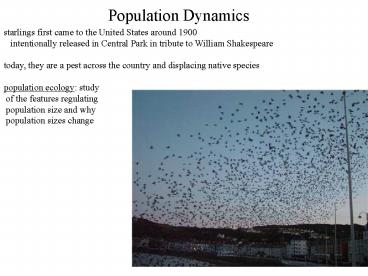Population Dynamics - PowerPoint PPT Presentation
1 / 12
Title:
Population Dynamics
Description:
Population Dynamics. starlings first came to the United States around 1900. intentionally released in Central Park in tribute to William Shakespeare ... – PowerPoint PPT presentation
Number of Views:41
Avg rating:3.0/5.0
Title: Population Dynamics
1
Population Dynamics
starlings first came to the United States around
1900 intentionally released in Central Park in
tribute to William Shakespeare today, they are a
pest across the country and displacing native
species population ecology study of the
features regulating population size and why
population sizes change
2
Population Dynamics
population density individuals per area or
volume often estimated based on sampling
and/or indirect indicators dispersion pattern
how individuals are spaced within their area
clumped individuals congregate in patches (most
common) uniform equal distribution across the
area random no obvious pattern-- scattered
clumped uniform
random
3
Population Dynamics
life table way of determining at what age
individuals tend to die survivorship curve
proportion of individuals alive at each age 3
major shapes defining life strategies I- few
offspring, long life, die at end II- constant
mortality over life span III- many offspring,
few survive to old age
4
Population Dynamics
different mathematical models can be used to
describe population growth exponential growth
doubles every period of time-- bacterial growth
not limited by food exponential growth cannot
continue for very long at all due to food/space
limits limiting factorenvironmental
characteristic that prevents exponential
growth logistic growth model S-shaped curve
where a population initially grows
exponentially, then levels off because of
limiting factors such as food or space
5
Population Dynamics
carrying capacity how many individuals an
environment can support can change based on
the number of other organisms present in
logistic growth models, populations grow slowly
when they have few individuals or 'many'
individuals (as it approaches carrying
capacity) There are many factors that go into
determining carrying capacity food shortages can
cause birth rates to decline space can also be a
limiting factor some species require a large
range for a healthy population population
density also influences health and survival--
higher density makes disease spread much easier
and faster
6
Population Dynamics
other populations are killed off by abiotic
factors such as temperature or severe weather
phenomena some populations all die off (ie.
annuals) waiting for seeds or eggs to continue
the next generation of the species other
populations have boom-and-bust cycles-- rapid
increase followed by a rapid decrease sometimes
one population will directly follow another
(either prey or predator)
7
Population Dynamics
life history series of events from birth to
death that occur to an organism some key
events- reproduction, offspring, parental care
given agave is a desert plant that stores
nutrients most years- when a wet year occurs,
they reproduce in a large, resource- using
way r-selection life history traits that
maximize reproductive success in uncrowded,
unpredictable places generally organisms will
die anyway K-selection reproduction occurs
late and offspring are often cared for more
common in larger organisms close to their
carrying capacity
8
Population Dynamics
predation can influence life histories guppies
are small tropical fish in the wild, when
killfish eat small, immature guppies, they
reproduce late after growing fairly large if
cichids that eat larger guppies are the main
predator, they reproduce at a smaller size
these reproductive strategies are heritable (and
therfore a form of evolution)-- they maintain
their strategy in aquariums without predators
9
Population Dynamics
sustainable resource management level of
harvesting some population that can be
continued year after year without damaging the
population maximum sustained yield is the goal
of resource management for many food
populations, though, ecological concerns are
ignored for economic and/or political
reasons fish species are often at risk because
nobody owns the oceans and it is very hard to
accurately count the fish poor fish estimates
allowed overfishing of cod in the northeast
10
Population Dynamics
the human population has been growing
exponentially in recent history this can't
continue forever- eventually the carrying
capacity of the earth will be reached (some
people think it's already past) only recently
have humans lived longer and reproduced more
effectively due to improved sanitation,
medicines, nutrition, etc recently population
growth has slowed mostly in the developed world
and China India and China are by far the most
populous countries-- India has not slowed its
growth rate as China has
11
Population Dynamics
Earth's carrying capacity is limited- the world
cannot support everyone in the style of the
US US citizens consumed significantly more
resources than the US has and approximately 4
times more than the world can support continued
growth requires sacrificing living standards to
support demands or faster exhaustion of
resources When resources of an ecosystem are
exhausted, populations crash unlike bacteria,
humans can choose how fast we reproduce
meat consumption
12
Population Dynamics
human population growth is made up of all
individual country rates made up of combined
rates of births and deaths zero population
growth (ZPG) when population densities are
constant can have high birth and high death
rates to give ZPG can have low birth and low
death rates to give ZPG age structure
proportion of individuals in a population of
different ages high birth, low death rates
growth low birth, high death rates
decline because humans live long, it takes
years to change populations overall but effects
are seen in young people































